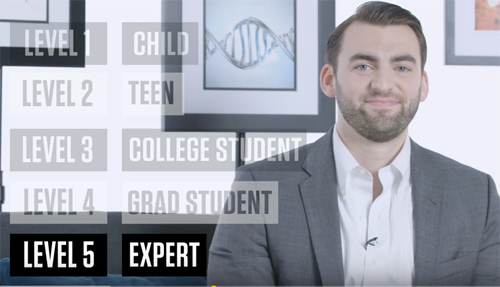Tuesday, 18 September 2018
There’s No Such Thing as a "Left-Brained" or "Right-Brained" Personality

In an earlier post in this blog, I addressed the widespread but mistaken idea that some people are more “left-brained” while others are more “right-brained”, and that the former are more rational while the latter are more creative. No evidence for this idea was found in a study on brain connectivity in over 1000 individuals, reported in the article “An Evaluation of the Left-Brain vs. Right-Brain Hypothesis with Resting State Functional Connectivity Magnetic Resonance Imaging”, published in August 2013 in the journal Plos One. (more…)
From Thought to Language | No comments
Tuesday, 4 September 2018
Cortical Gradients (bis)

As promised in my last post, I’m going to talk a bit more today about an article entitled “Large-Scale Gradients in Human Cortical Organization” that appeared in the journal Trends in Cognitive Sciences (TiCS) in January 2018,
In that last post, I described how the gradient from the more unimodal parts of the cortex (the primary sensory areas) to the more multimodal parts (the more associative ones) provides insight into the organization of large functional networks in the brain, such as the default mode network, which lies at multimodal end of this gradient. (more…)
Thursday, 16 August 2018
Human Brain Networks Operate on a Unimodal/Multimodal Gradient

This week I’d like to tell you about an article published in the journal PNAS in 2016. It is of interest because it does something that is extremely valuable in the realm of science: it shows how two bodies of data converge into a single phenomenon and thereby helps us to understand some things that were less clear before. Let me explain.
The article, by Daniel S. Margulies and no fewer than 11 co-authors, is entitled “ Situating the default-mode network along a principal gradient of macroscale cortical organization”. In slightly simpler terms, their study involved situating the brain’s default mode network along a large-scale organizational gradient within the cerebral cortex. Okay, let me explain further. (more…)
From the Simple to the Complex | No comments
Friday, 27 July 2018
Two Books on the Enactive Approach in Cognitive Science

This week, I’d like to tell you about two books on the philosophy of cognitive science. Both of them were published in 2017, and both of them deal with the enactive approach first proposed in the 1990s by pioneers such as Francisco Varela and Evan Thompson. Since then, the enactive approach has become a major research topic in contemporary cognitive science, so it is no surprise that entire books are now devoted to it.
The first of these two books is Sensorimotor Life: An Enactive Proposal, by Ezequiel Di Paolo, Thomas Buhrmann and Xabier E. Barandiaran. (more…)
Body Movement and the Brain, From Thought to Language | No comments
Wednesday, 4 July 2018
Explaining Science Not at Three Levels But at Five
 This week I’d like to draw your attention to a series of videos that the U.S. magazine Wired published on YouTube in spring 2017. In each episode of this series, an expert in a particular scientific field explain a complex concept in that field to five different people: a 5-year-old, a teenager, a college student, a graduate student and a colleague who is also an expert in that field. Thus you watch the expert explain the same concept five times—from the simplest possible explanation for the 5-year-old to a high-level discussion with the colleague. This is a highly original teaching approach that you don’t see very often, except on some websites where you can drill down from a simpler explanation to a second, more advanced one, or on a certain website about the human brain that provides three levels of explanation at five levels of organization (and whose author clearly must be obsessed with levels, probably because he read too much Laborit in his youth ;-P ).
This week I’d like to draw your attention to a series of videos that the U.S. magazine Wired published on YouTube in spring 2017. In each episode of this series, an expert in a particular scientific field explain a complex concept in that field to five different people: a 5-year-old, a teenager, a college student, a graduate student and a colleague who is also an expert in that field. Thus you watch the expert explain the same concept five times—from the simplest possible explanation for the 5-year-old to a high-level discussion with the colleague. This is a highly original teaching approach that you don’t see very often, except on some websites where you can drill down from a simpler explanation to a second, more advanced one, or on a certain website about the human brain that provides three levels of explanation at five levels of organization (and whose author clearly must be obsessed with levels, probably because he read too much Laborit in his youth ;-P ).
So you can understand why I couldn’t resist telling you about this web series, especially since one of the episodes deals with the connectome, a neuroscientific research topic that I have discussed previously in this blog and also teach in some of the courses that I give in French in Montreal. (more…)
From the Simple to the Complex | No comments







